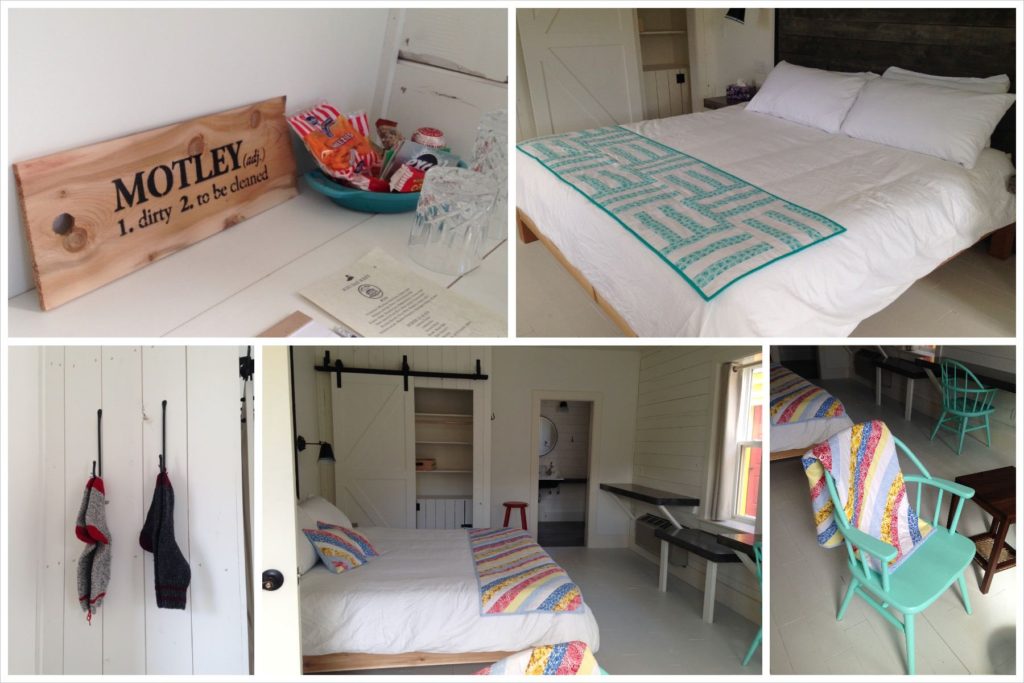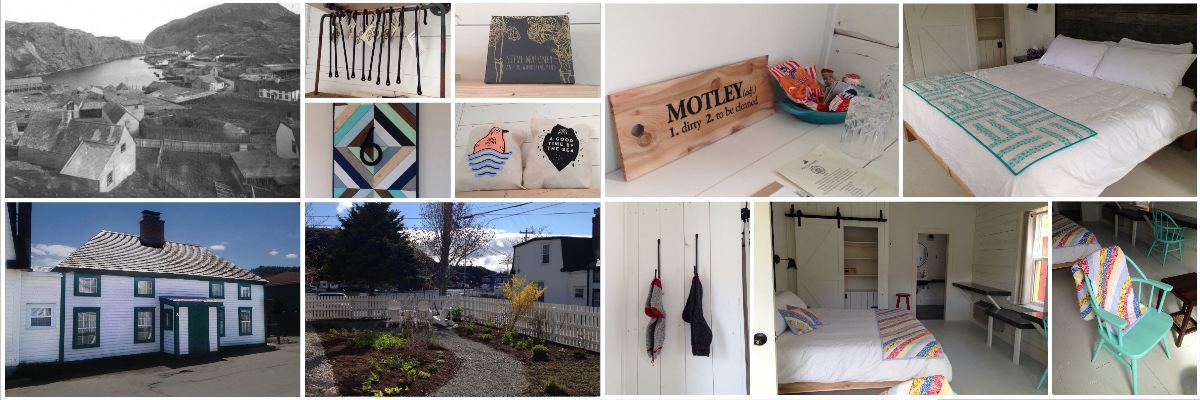New Life in Quidi Vidi Village
BY Ellen Curtis
July 2017
Picturesque Quidi Vidi Village is home to a bevy of beautiful colours and buildings. History hides in every nook and cranny here, but so does innovation. This fusion of old and new is represented best in Mallard Cottage, an 18th century Irish-Newfoundland vernacular style cottage, currently enjoying a rebirth under the ownership of chef Todd Perrin. We spoke to Todd recently to find out what new things the future holds for Quidi Vidi Village, and for the province’s food industry.
The draw of Mallard Cottage.
Todd: I was living in the area and Mallard Cottage was always a building that interested me, but it was a building that you would never expect to see a ‘for sale’ sign on. When it went on the market, my wife and I were intrigued. We took a while to put an offer on it. It was almost on a whim that we finally did.
No fairy-tale version of NL.
Todd: We are in a really unique corner of the country. We don’t want to create a Disney-fied version of Newfoundland. It’s as simple as building a square wooden building to be true to our history. We are very fortunate that that aesthetic is what we like, and we take it very seriously. It’s not a stretch for us. It’s what we like and it’s natural.
Growing agriculture to grow the restaurant industry.
Todd: Making local food more accessible would be huge. In terms of our fisheries, that means making it easier for restaurants and people to have a direct line to the source. In some ways, the policies they’ve put in place over the last few years have actually made that a little bit more complicated. They’ve just announced a new policy making it easier for people to buy land for local agriculture, so they seem like they’re putting money and effort into food production but, like most things in government, the best thing they could do is remove some of the hoops. Obviously, you need some quality control, but people have been growing food for ages. We just need to make it possible for people to grow food and sell it here locally.
Food security.
Todd: Food security is a huge issue for us. We’re only ever a few storm days away from seeing empty shelves in the grocery stores. There was a time when Newfoundland was self-sufficient because we had to be but, with the modern conveniences, we aren’t anymore and we’re at the mercy of the weather. In some ways, we’re worse off than 100 years ago. We need to look at creating more of a locally based economy. We’re in 2017, but there’s times when the ferry can’t cross, so we need to take our destiny into our own hands. We’ve done it before, so we can certainly do it again.
The emphasis on sourcing locally, despite challenges.
Todd: With vegetables, we’re limited in the variety. We’re challenged with some protein- there is lamb, pork, and beef, but sometimes lamb and beef are hard to come by. Seafood, of course, is always up and down, so trying to find a steady supply for our busy restaurant has been hard. We’ve had to become good at thinking on the fly, so now we’re at a place where if we can’t find something, we deal with it.
The main benefit of sourcing locally is that we get to highlight local food, putting the best of Newfoundland and Labrador on the plate. The cost is good too because we don’t have to ship things in. We know the farmers. They’re personal friends. The close connection is the best
Community connection.
Todd: I think that we’ve done our best to be a good neighbour. It’s been a thriving community in the past, once with two fish plants, but there have been ups and downs here with activity. Our neighbours put up with the challenges of having a busy restaurant here though, and they’ve been great supporting the village as a tourist destination, with the brewery, and the scenery, and everything else down here. We try not to affect anyone’s quality of life, and I think they appreciate what we’ve tried to do with the community.
From day one, the people we have working with us have been so important. Their commitment has been everything. We’ve been so lucky to have surrounded ourselves with people who have the same idea for what the restaurant and Quidi Vidi should be going forward.
Expanding horizons.
Todd: We’ve just opened a small inn across the road from the restaurant. People can come and stay in the community. At the same time, we’re also still working on partnerships to further develop the waterfront. Plans are constantly evolving, but, whatever goes there, we want to carry that aesthetic through so the building looks like it’s always been there. The goal will be to make this area an even greater tourist destination.
Building old Newfoundland into a new structure.
Todd: With the Inn, we tried to emulate what we did in Mallard Cottage. We tried to use wood and clapboard where we could and tried to maintain that Newfoundland vernacular. It’s simple in a lot of ways. People have no idea that this is a newer building when they look at it.
The new-old design.
Todd: The Inn is a basic, saltbox style. We used square boxes, but no high roofs because we didn’t want to skew the scale on such a large building.

Top left: An archival photo shows Quidi Vidi Village, with Mallard Cottage on the right. Bottom left: Mallard Cottage today. Top right: Locally made art and music, on display at the Inn by Mallard Cottage. Bottom Right: The edible garden in front of the Inn by Mallard Cottage.
Architecture and people. And weather.
Todd: It goes both ways; the people shape the architecture and the architecture shapes the people. It’s what Newfoundland does. It’s in the weather, climate, landscape, and how our architecture has come out of building what we had because we had to, so now we are continuing that idea.
Looking forward.
Todd: Well, I think in Quidi Vidi Village it’s going to be about realizing what it is- it’s a huge tourism draw that hasn’t had enough infrastructure development. Thousands come through every year, tourists and locals alike, to see the beauty of it. People love to spend time down here, but there’s nowhere to get a bottle of water or for tourists to spend their money. We’re trying to blow the dust off it now, and allow people to enjoy the natural beauty that is Quidi Vidi. I think you’re going to see a lot of change for the good.
What doesn’t work.
Todd: We pushed ahead with business down here because we felt like it was the right thing to do. A lot of the motivation for Mallard Cottage and the Inn and for the waterfront is as much about what doesn’t go there as what does. We wanted to be part of the direction development was happening in so that it didn’t go off the rails.
It’s a personal interest of ours. We are motivated by trying to do something good. It’s an opportunity that’s not been capitalized on. Quidi Vidi Village has been a tourist destination for a long time, but in the last five years we’ve seen a lot of growth. Momentum is building. The market is here, the place is beautiful, why wouldn’t you love to live and work here? There are not many places in the world where all these factors come together, being so close to the East Coast trail, the airport, Signal Hill. Other places would kill to have those things. We are very fortunate to have taken the plunge.
Traditional materials.
Todd: We tried to use traditional materials everywhere, we used Newfoundland spruce for the walls and floor, for example. Jessica Waterman provided us some of her work, we have local CD’s, forged goods from Ian Gillis, West Coast craftspeople from the Jackson’s Arm Heritage Society provided the quilts and socks you’ll see in the rooms, and the soap we have is sourced locally too. We try to touch on every aspect, and I don’t think we’re unique in that regard, because to do it that way makes sense.

Interior shots from the rooms at the Inn by Mallard Cottage. Amenities include some classic Newfoundland snacks, homemade quilts, and knitted socks to keep guests cozy.
Why?
Todd: There is a perception that restoring heritage is more expensive than building new, or that it’s too difficult, but that’s not our experience. You have to have a different attitude, a different sensibility, and we have a lot of heart and soul and there is a lot of what we do that’s not rooted in making money. We are trying to make a business, employ people, and get paid, yes, but that’s not necessarily what motivated us. Sometimes in this town, developers get a bad name, and I think we’ve added something to the area instead. We’re focussed on adding to the community, not our wallets.
We are in a tourist village, and peoples’ perception of Newfoundland is not Stavanger Drive or Kelsey Drive. We are trying to give people that experience. There are great pockets of that throughout the province, places like Bonavista, Trinity, Twillingate, and on the West Coast.
People want to see and stay in traditional architecture, but we haven’t done a good job of providing that in St. John’s, even though we are the biggest outport in Newfoundland. You can maintain those values in St. Johns, so we saw an opportunity to bring some of that back.




